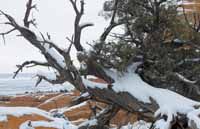| Mounds of unmelted snow continue to blanket the landscape in the Castle Valley area and the mountains surrounding Carbon County. Although Utah and the upper Colorado region recorded the lowest preciptation amounts during the five-year drought last year, the U.S. Bureau of Reclamation expects the federal agency’s smaller water storage reservoirs at location across Utah, including Scofield, to fill to capacity during 2004. |
The state and the entire upper Colorado region recorded the lowest amounts of precipitation during the five-year drought in 2003.
Although the region continues to report below average water storage levels, the United States Bureau of Reclamation expects Utah’s smaller reservoirs, including Scofield, to fill to capacity in 2004.
The region encompasses Utah, western Colorado and New Mexico. Location represents one reason contributing to low reservoir storage levels.
As the federal agency tasked with containing water behind federal dams, Reclamation is concerned not only with engineering, but also stream flows.
“In the case of northern Utah, it’s kind of a transition zone similar to northern Colorado,” pointed out drought prediction specialist Douglas LeComte.
Due to geographic conditions, El Nino and La Nina have little effect in the region. The phenomena are related to the idea that Pacific Ocean surface temperatures affect the possibility of inland rainfall.
El Nino’s effect is to warm ocean water, which has a tendency to produce above average precipitation in the southern and southwestern U.S., explained reclamation’s Provo office. La Nina is primarily associated with cool ocean water and below average precipitation in the north,
In late 2003, the jet strewn brought frequent storm systems to the Pacific northwest, dropping between two and eight inches of precipitation from coastal Washington to Oregon eastward into the Cascades and northwestern California. However, the heaviest rain and snow fell outside the drought area.
Although the recent winter storms have dumped an above average amount of snow for the present time of the year, LeComte remained skeptical regarding the water outlook in Utah and the region.
“What we are hearing is – even if it’s a normal winter in terms of snowfall for much of the West, it won’t be enough to end the water shortages. Even one or two big snowstorms won’t do it. You’ll probably need a dozen big snowstorms,” said LeComte.
But Brian McInerney, a hydrologist with the National Weather Service office in Salt Lake City, disagreed with the assessment.
“If the snowpacks were 10 or 20 percent of normal, I’d be worried,” said McInerney. “But we’ve got a very healthy snowpack at all elevations. And we’ve got weather patterns at this point that have been continuously stormy with no indication that we’re headed for any monstrous high pressure in the near future.”
The BOR hydrologist agreed that reservoir storage levels are down in Utah and need to be recharged.
“We’ll need multiple years to recharge the larger water stores like the Bear Lake, the Great Salt Lake, Utah Lake, Flaming Gorge and Lake Powell. But normal runoff could essentially fill the small higher elevation reservoirs,” noted McInerney.
The National Weather Service hydrologist admitted that differing forecasts tend to confuse people.
“All 21 of reclamation’s Utah reservoirs are below their normal storage level for this time of year,” confirmed Jared Hansen, a hydrologist at BOR Provo area office.
Nevertheless, Hansen remained optimistic that smaller reservoirs at various locations across the state will fill to capacity in 2003.
Throughout the five-year drought, no municipal and industrial water deliveries were interrupted in Utah or the upper Colorado region, concluded the reclamation bureau.

